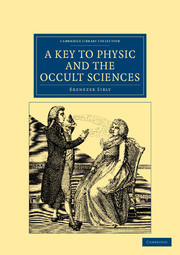Description
A Key to Physic, and the Occult Sciences
Cambridge Library Collection - Spiritualism and Esoteric Knowledge Series
Author: Sibly Ebenezer
An ambitious work of philosophy and medical theory, attempting to marry occult understandings of the body with Enlightenment science.
Language: English
Subject for A Key to Physic, and the Occult Sciences:
Approximative price 52.59 €
In Print (Delivery period: 14 days).
Add to cart
Publication date: 02-2012
428 p. · 21x29.7 cm · Paperback
428 p. · 21x29.7 cm · Paperback
Description
/li>Contents
/li>
Physician, astrologer and occult philosopher, Ebenezer Sibly (1751?99) wrote popular works of medical theory and advice, including Culpeper's English Physician (1789) and this companion volume of 1795. A synthesis of theology, natural philosophy and medical science, the book argues for a microcosmic understanding of the human body as a composite of the four essential elements. An ambitious work, it bears witness to an important era in the development of modern medicine, as Sibly looks to combine an older hermetic tradition with new Enlightenment-era insights into the physical universe. In the final section of the work, Sibly touts his remedies, Lunar Tincture and Solar Tincture, developed to act upon female and male ailments, respectively. Composed from the 'pabulum of the universe', these medicines, Sibly claims, cure everything from gunshot wounds to dog bites.
A key to physic and the occult sciences: 1. God, and nature; 2. Of nature; 3. Of the visible and occult properties of nature; 4. Of the first matter; 5. Of atoms, and their nature; 6. The properties, magnitude, figure, weight, and motion, of atoms; 7. Of sympathy and antipathy in natural bodies; 8. Of the occult properties of generation in plants and herbs; 9. Of sympathy, antipathy, sagacity, and occult instinct, in brutes; 10. Of animal flowers; 11. Of the polypus; 12. Of animalcules; 13. Of instinct; 14. Of scent; 15. Of man; 16. Of nutrition; 17. Of food, or aliment; 18. Of air; 19. Of exercise; 20. Of sleep; 21. Of dreams; 22. Of intemperance; 23. Of the passions; 24. Of impotency occasioned by fear; 25. Of grief; 26. Of love; 27. Of melancholy; 28. Of the prognostics of diseases, with rules for preserving health; 29. Angina pectoris; 30. Dangerous affection of the oesophagus; 31. Observations on the means of preserving health; 32. Of fixed air as a medicine; 33. Of medical electricity; 34. Of animal magnetism; 35. Arguments to prove, that animal magnetism is the cause of sympathy in man and other animals, and in plants, etc.; 36. Of antipathy; 37. Effects of antipathy and sympathy in brute animals; 38. Of attraction and repulsion, otherwise called sympathy and antipathy in plants; 39. Considerations on the indispositions and diseases of man; 40. Of indisposition and disease; 41. Of human impregnation; 42. Of feminine, or lunar diseases; 43. Chlorosis, or green sickness, by some called, the love-fever; 44. Of the fluor albus, or whites; 45. Of barrenness, or infertility; 46. Indispositions attendant on pregnancy; 47. State of women at the turn of life; 48. Of masculine, or solar diseases; 49. Scrophula, scurvy, or king's evil; 50. Debilitated, tainted, and enfeebled, constitutions; 51. A relaxed habit; 52. Hypochondriacal debility, or weak nerves; 53. Nocturnal emisions, or incontinence of the semen; 54. Onanism; 55. An impure or tainted habit; 56. A tainted habit in a state of pregnancy; 57. Tabes dorsalis, or consumption of the back; 58. Rheumatic gout; 59. Agues, convulsions, cholic, bloody-flux, and violent spasms in the stomach and bowels; 60. Diseases of the breast and lungs, asthma, dropsy, or consumption; 61. Mental depression, or lowness of spirits; 62. Bile on the stomach; 63. Bite of a mad dog, or any venomous reptile; 64. For gun-shot wounds, cuts, stabs, etc.; 65. Of the principles of life and death; 66. Of the crisis, or critical turn of a disease; 67. A lunar table; 68. On the difference betwixt a natural and violent death, exemplified by the fate of the late King and Queen of France.
© 2024 LAVOISIER S.A.S.

